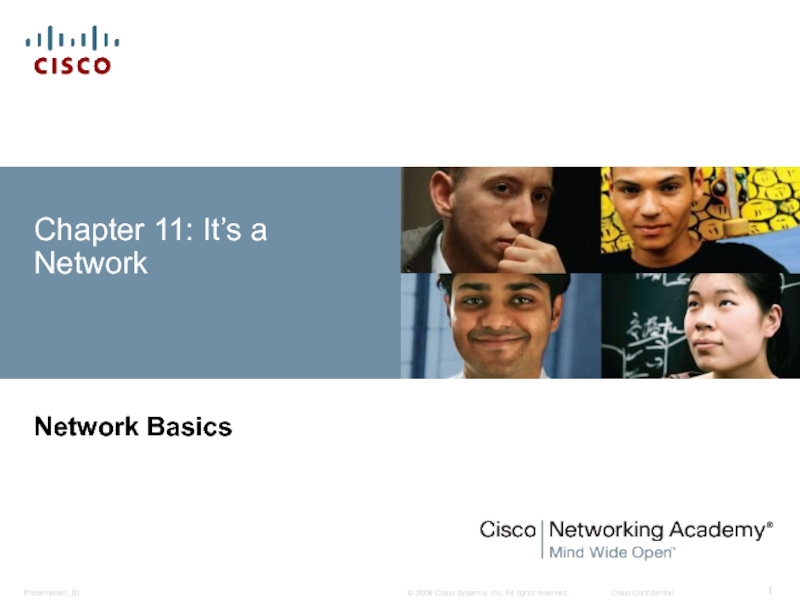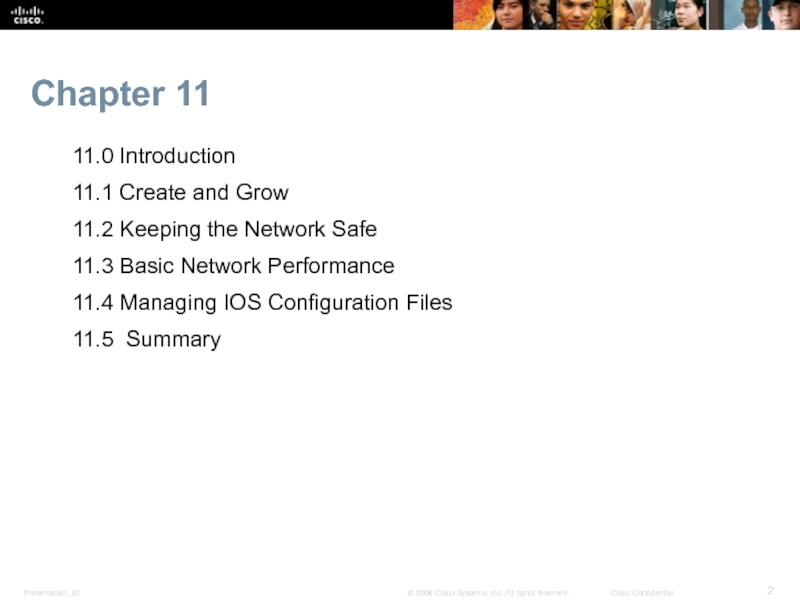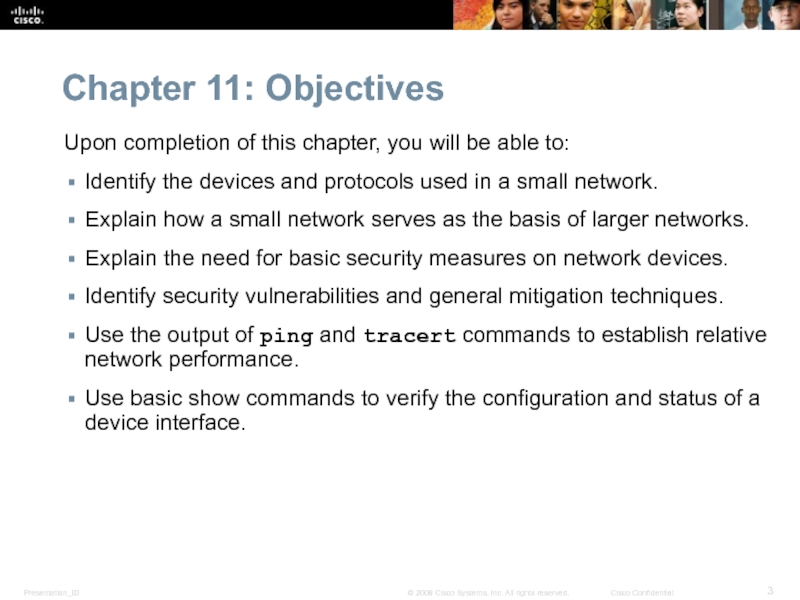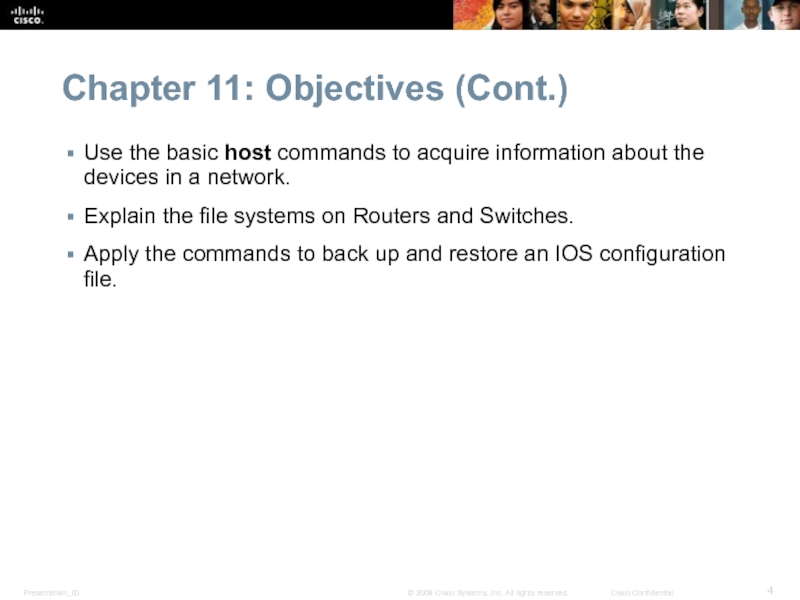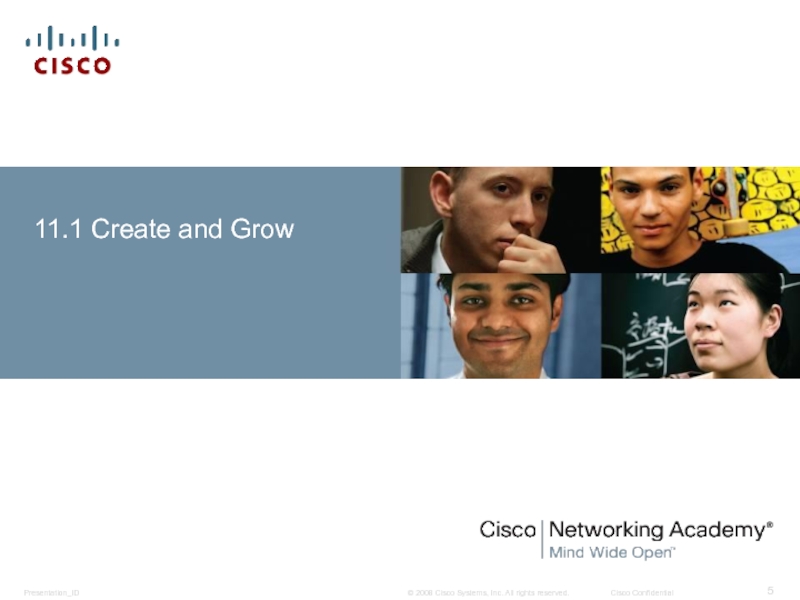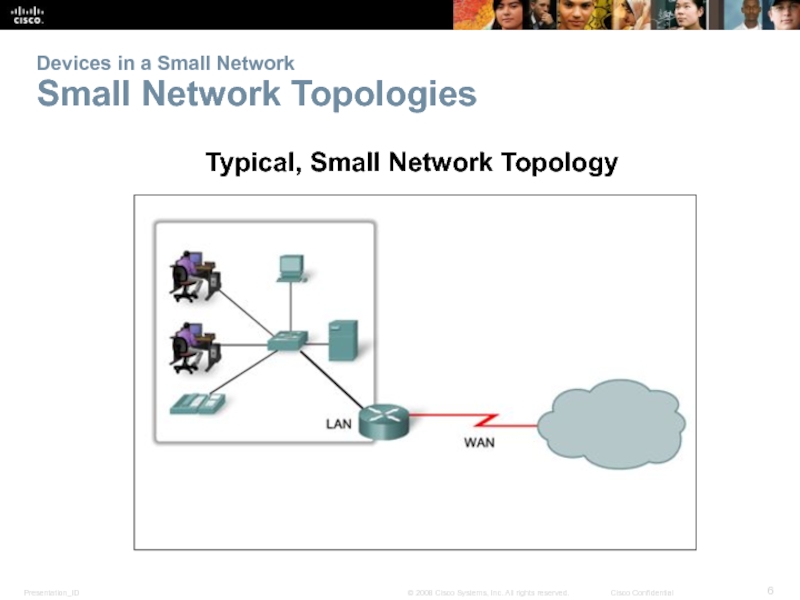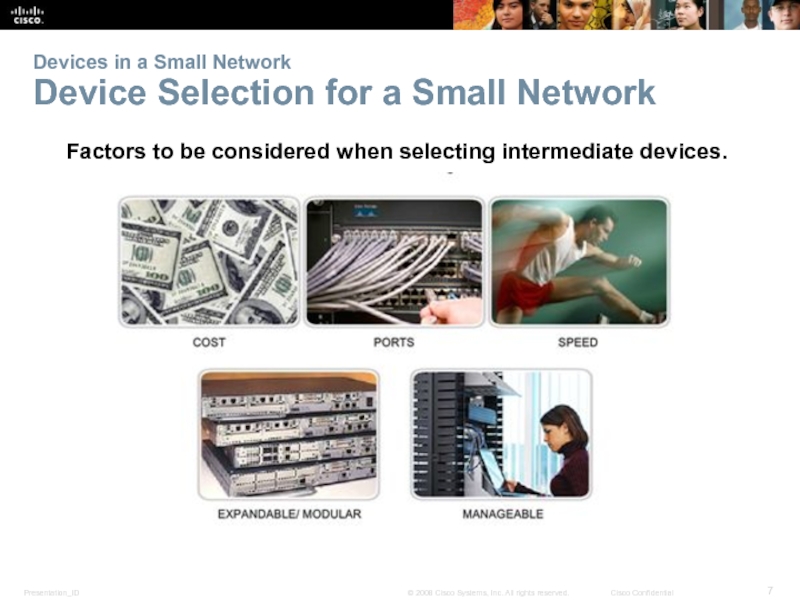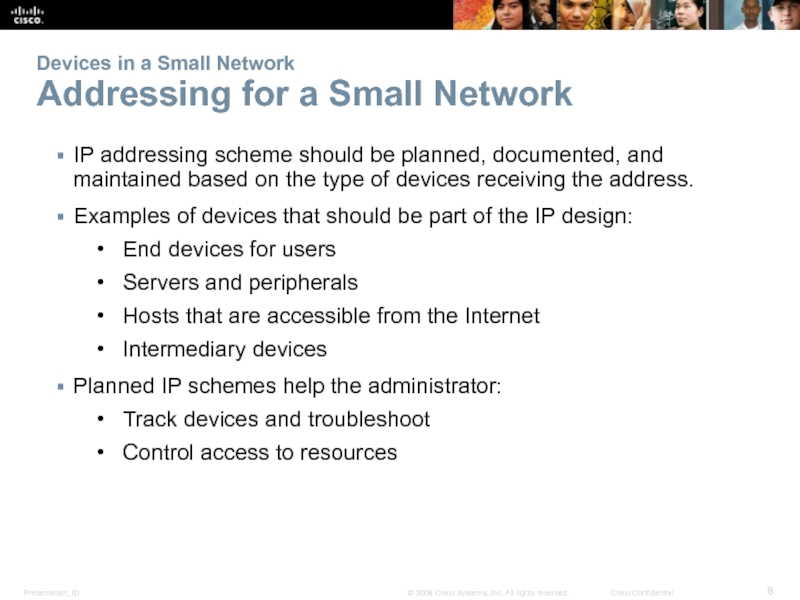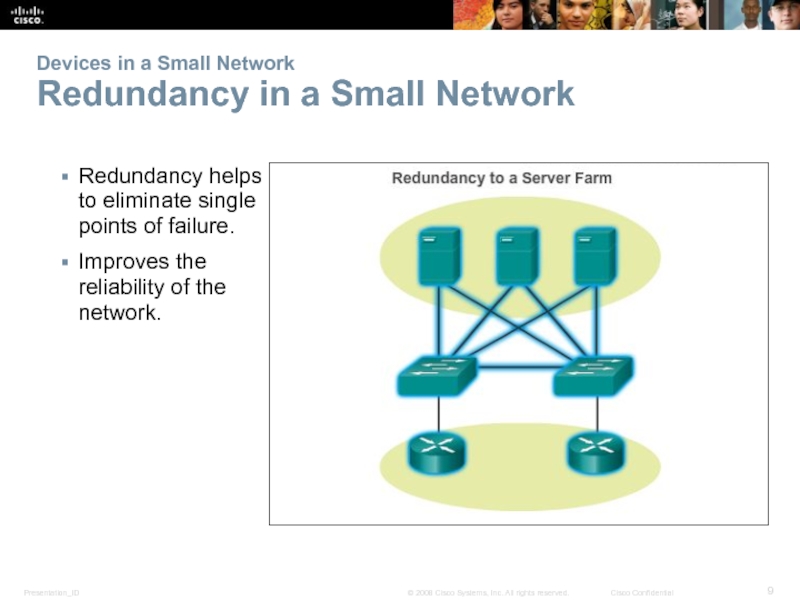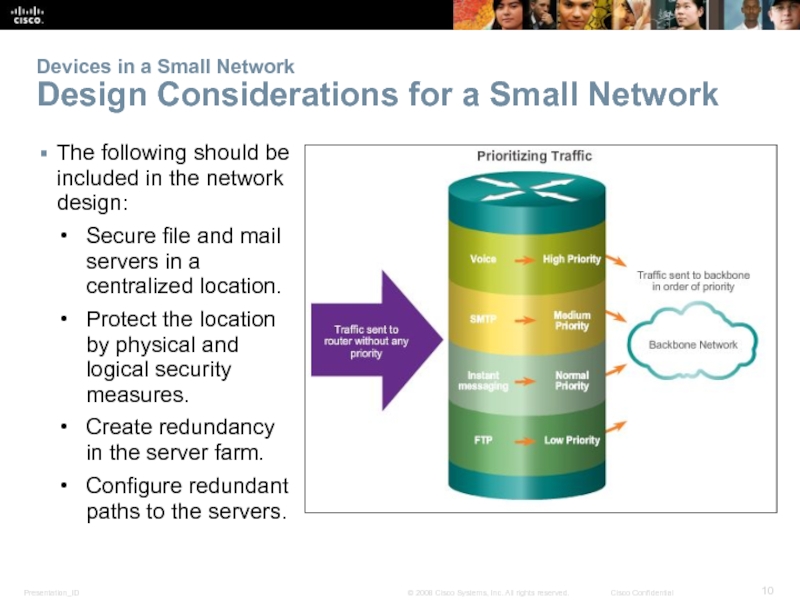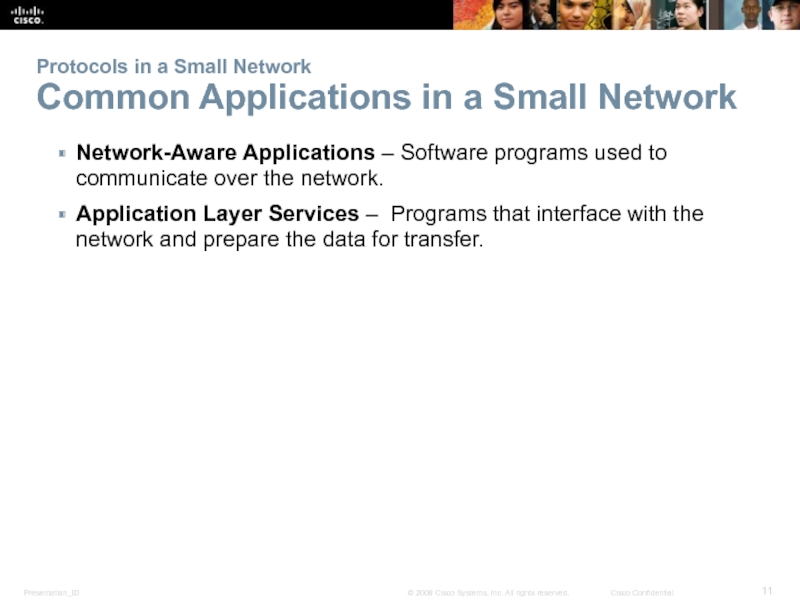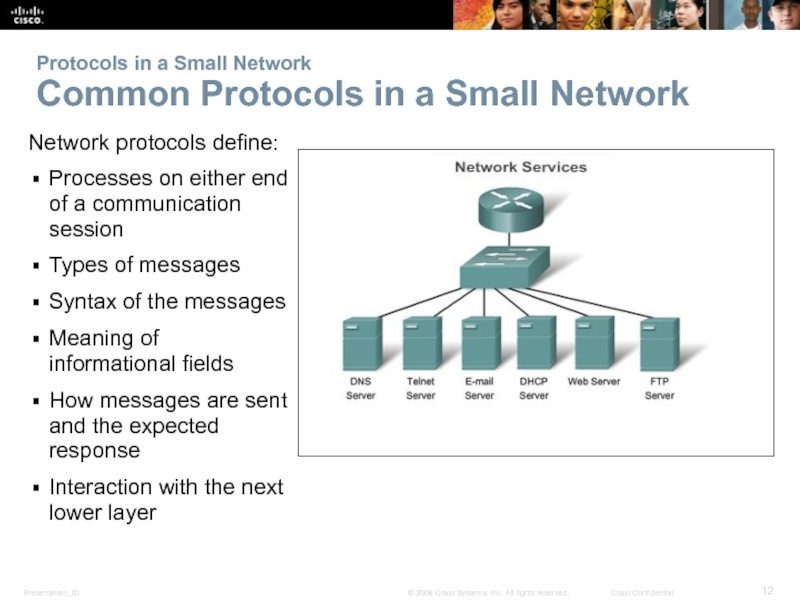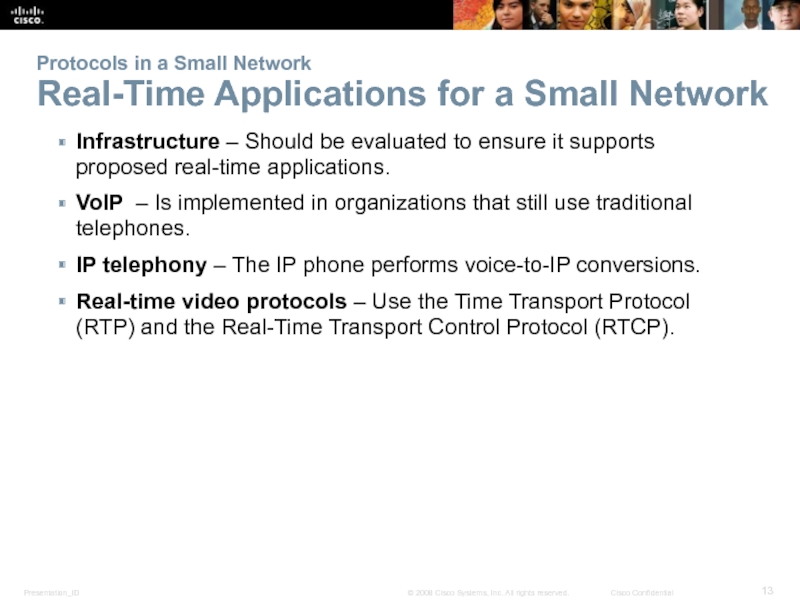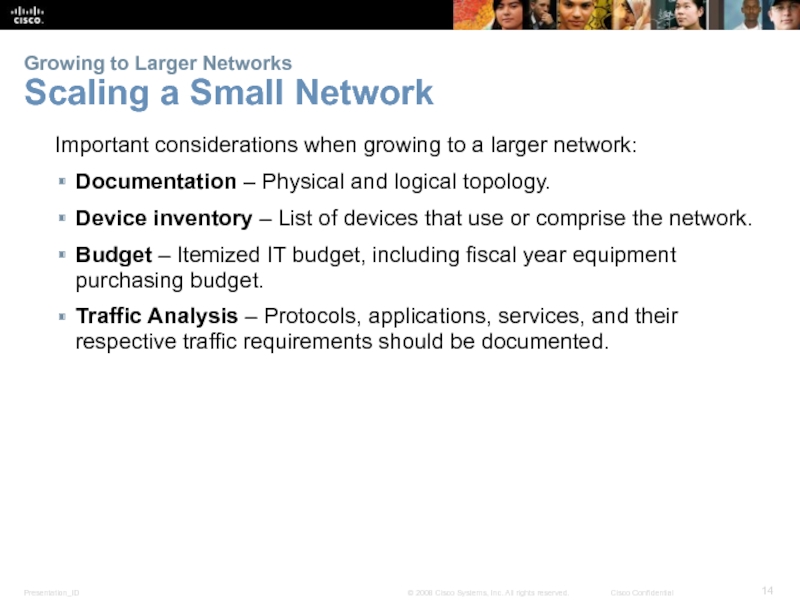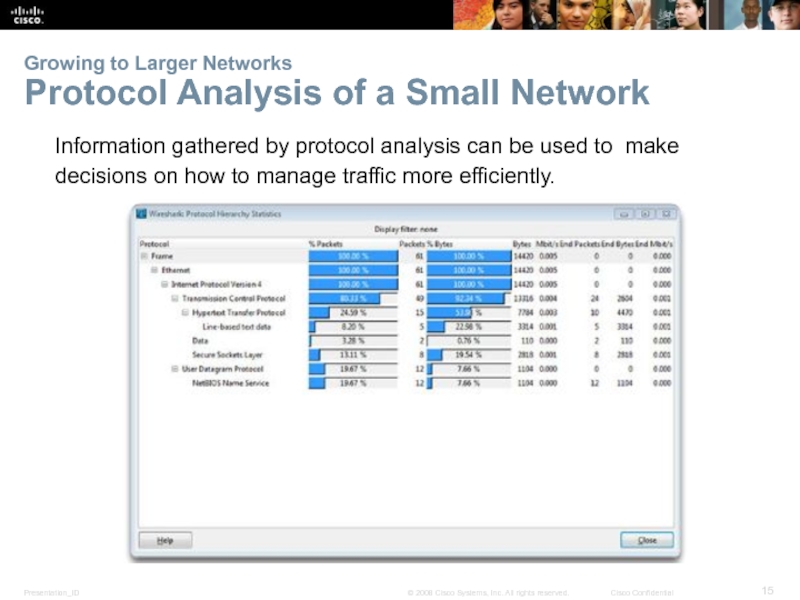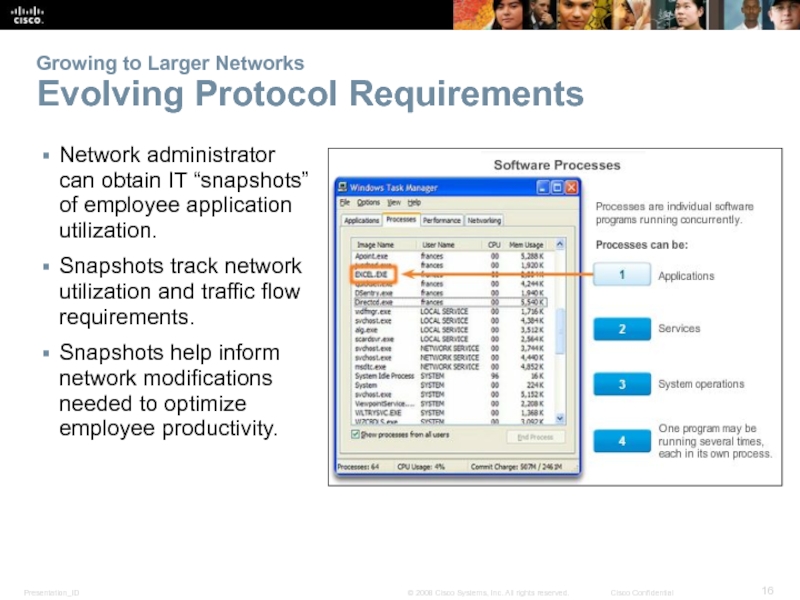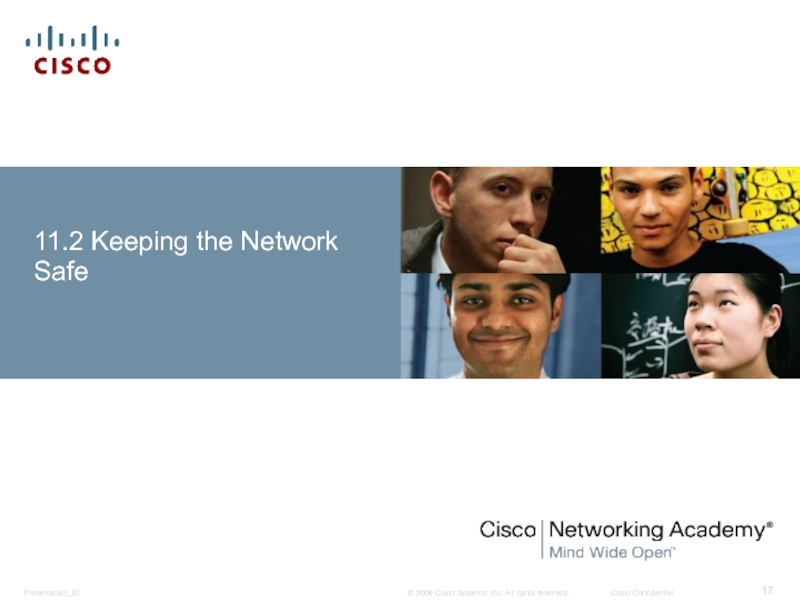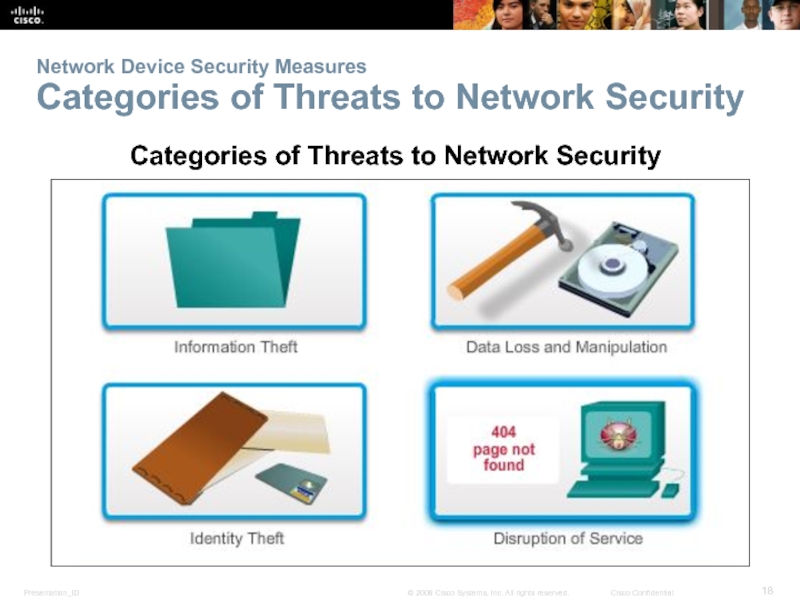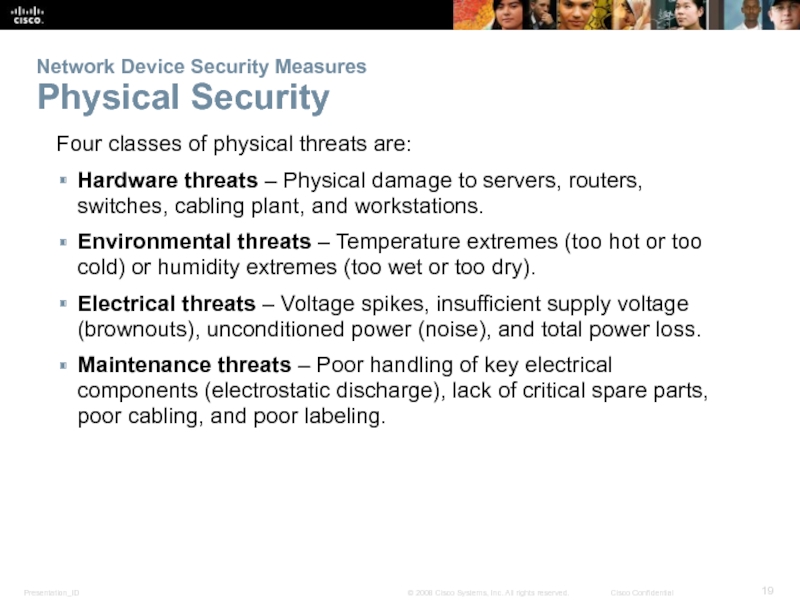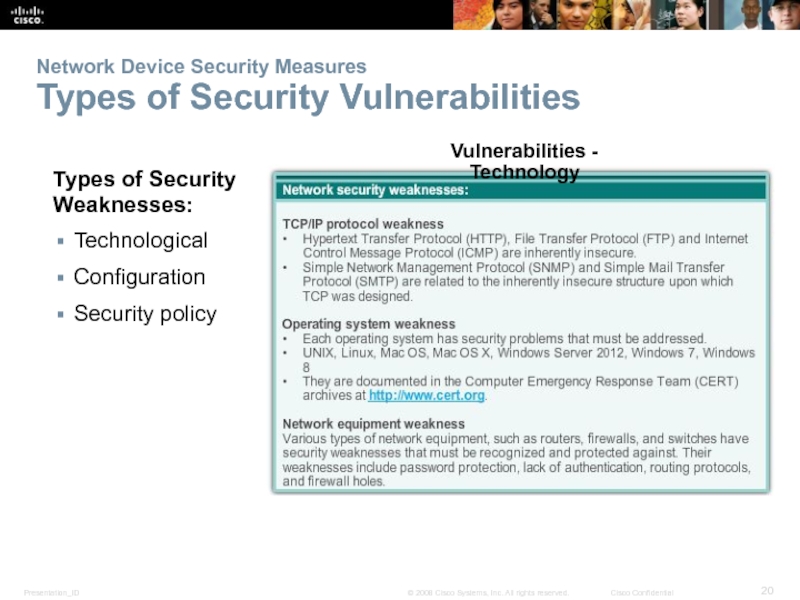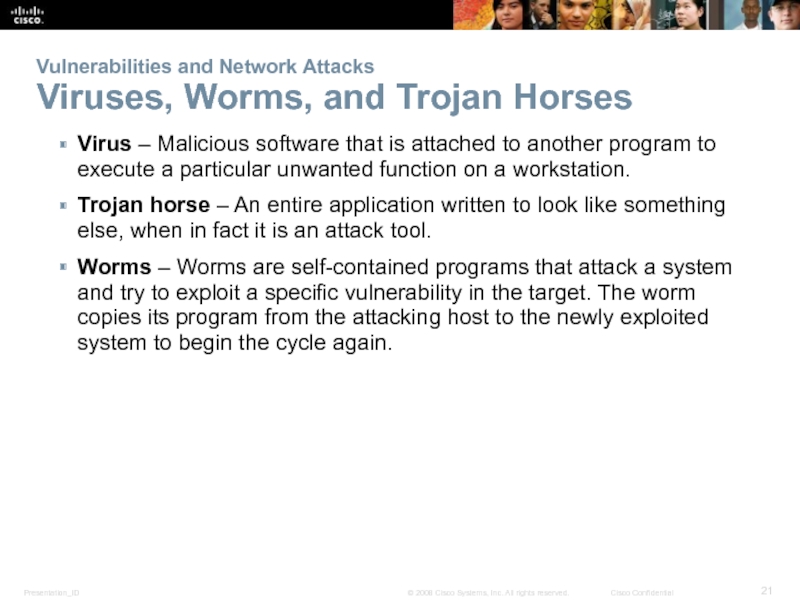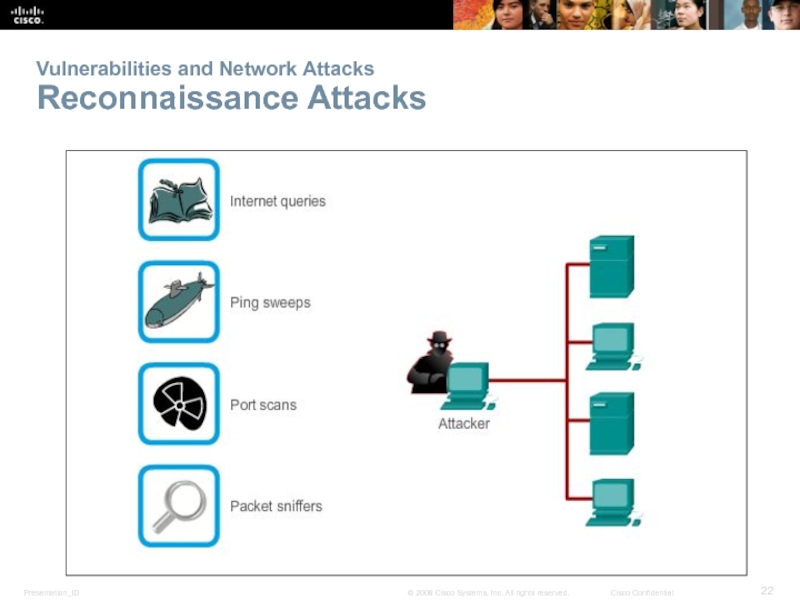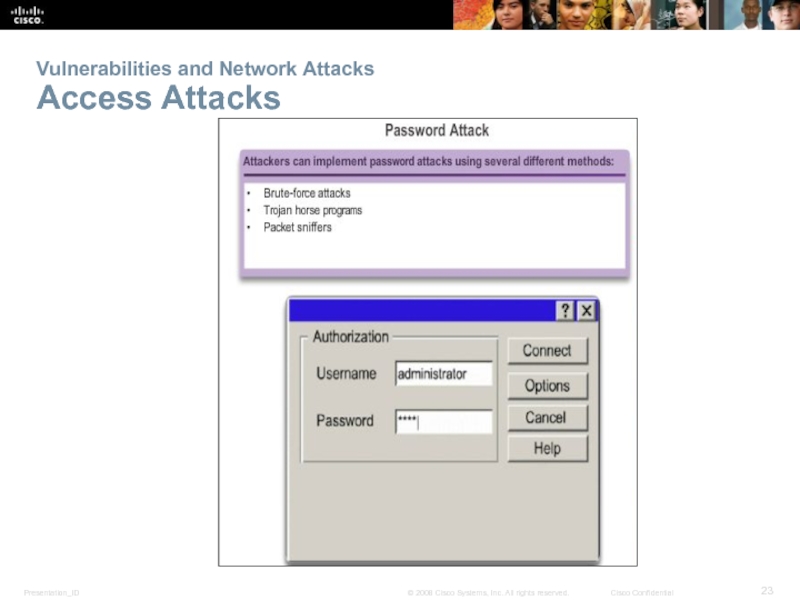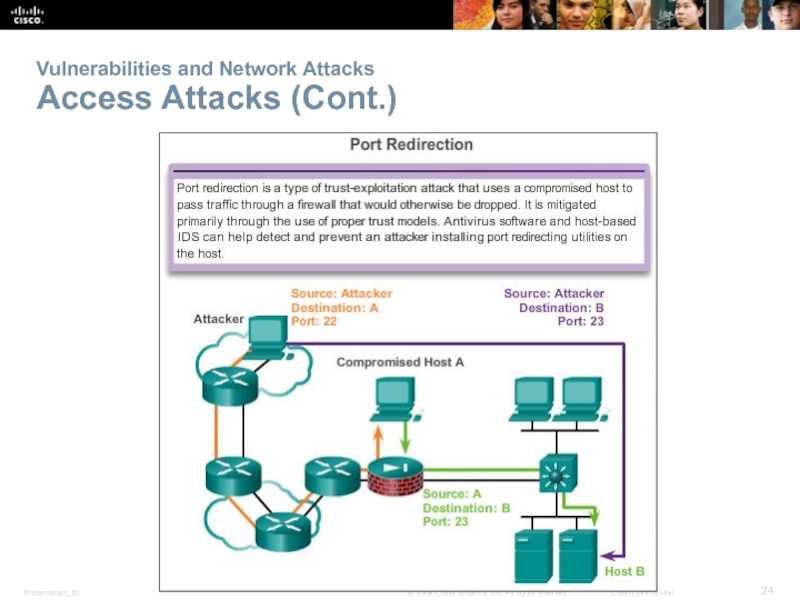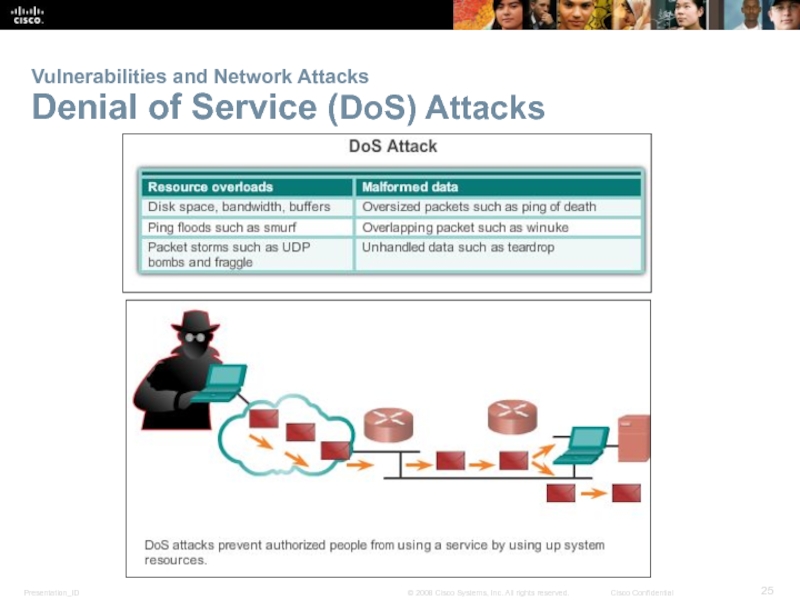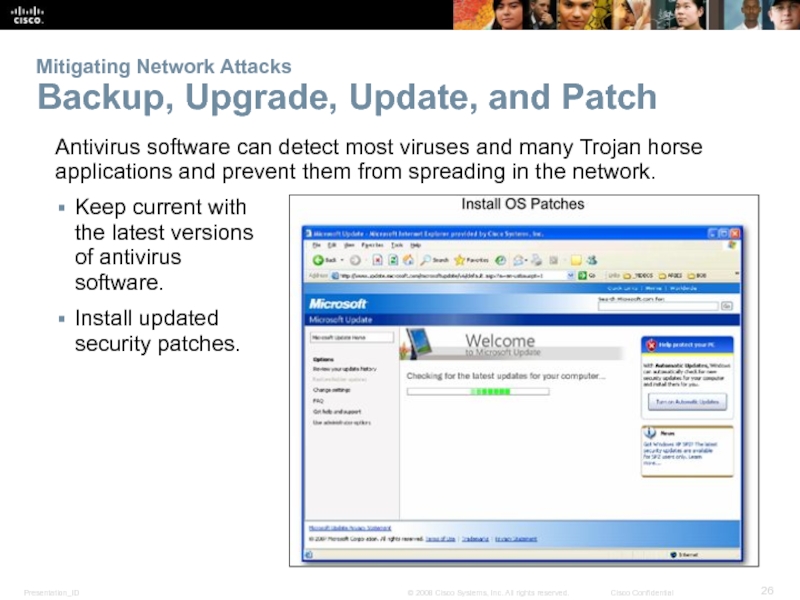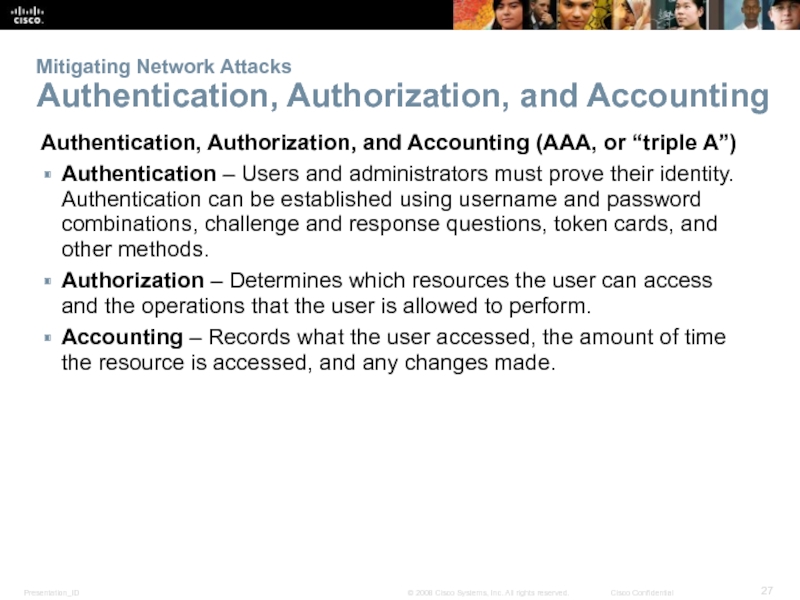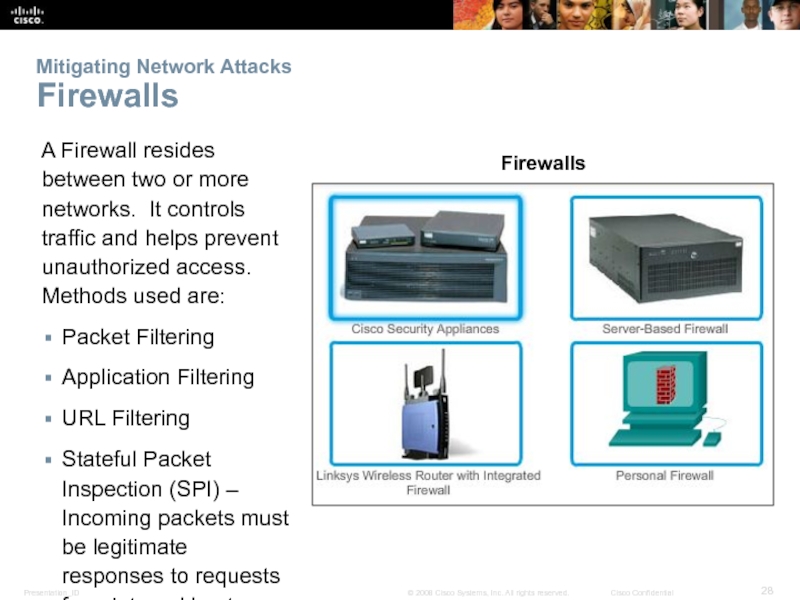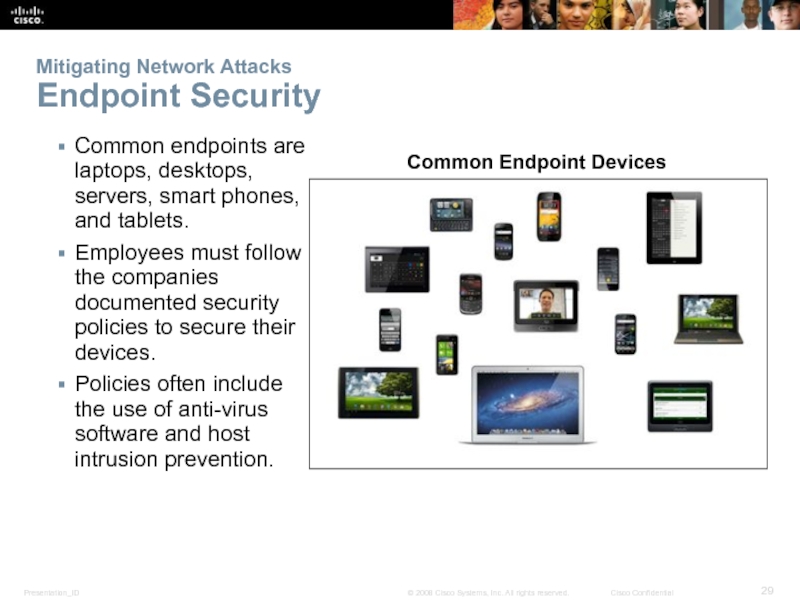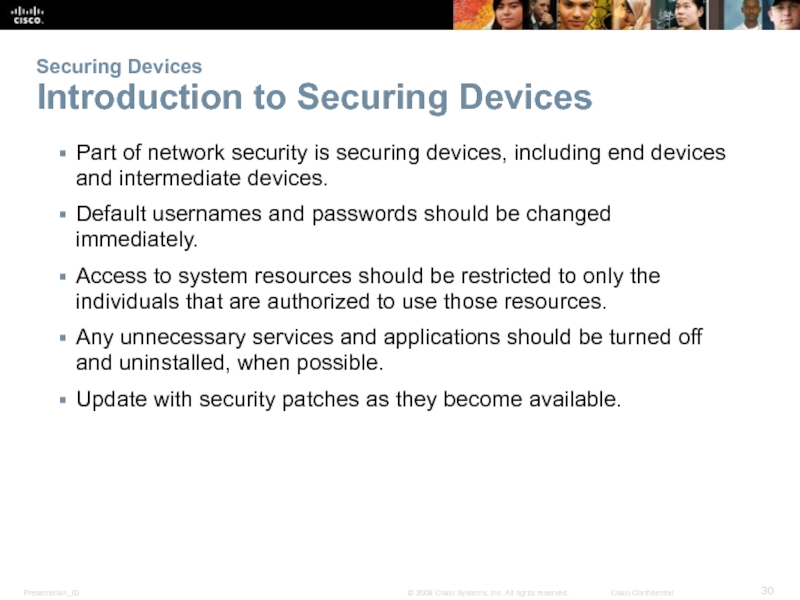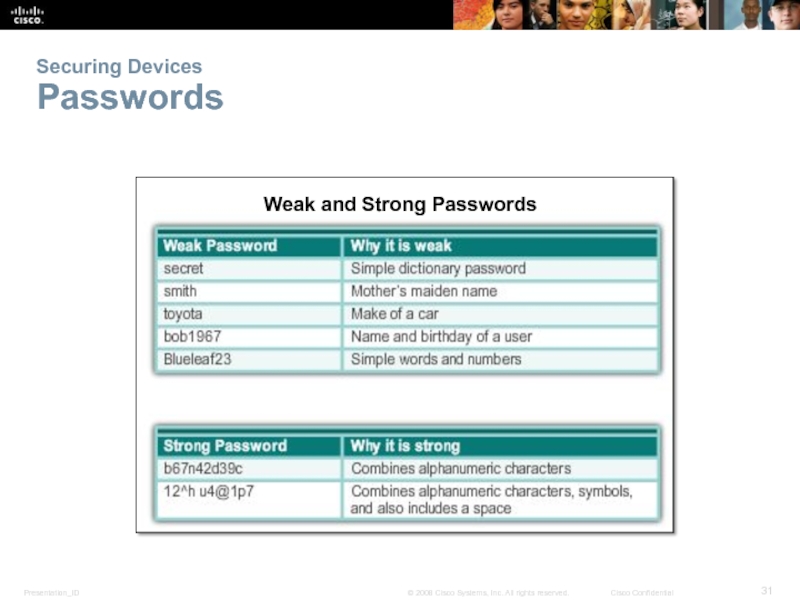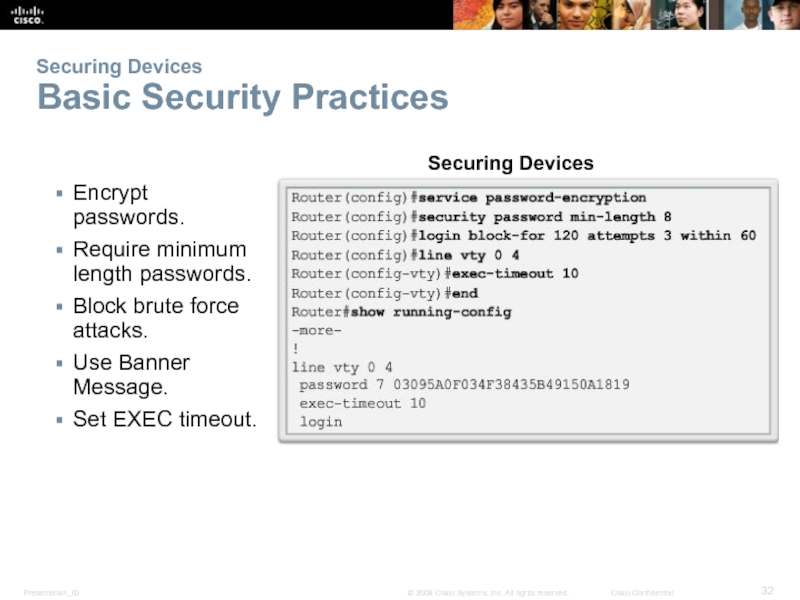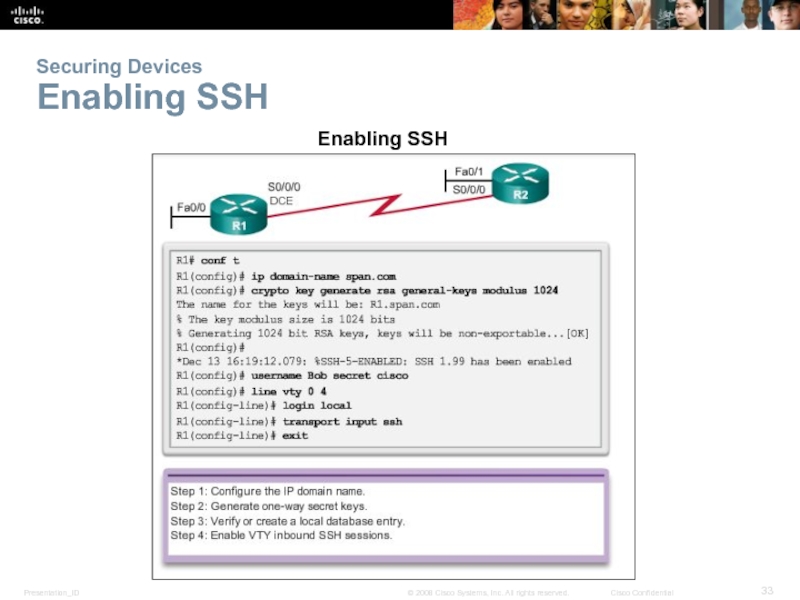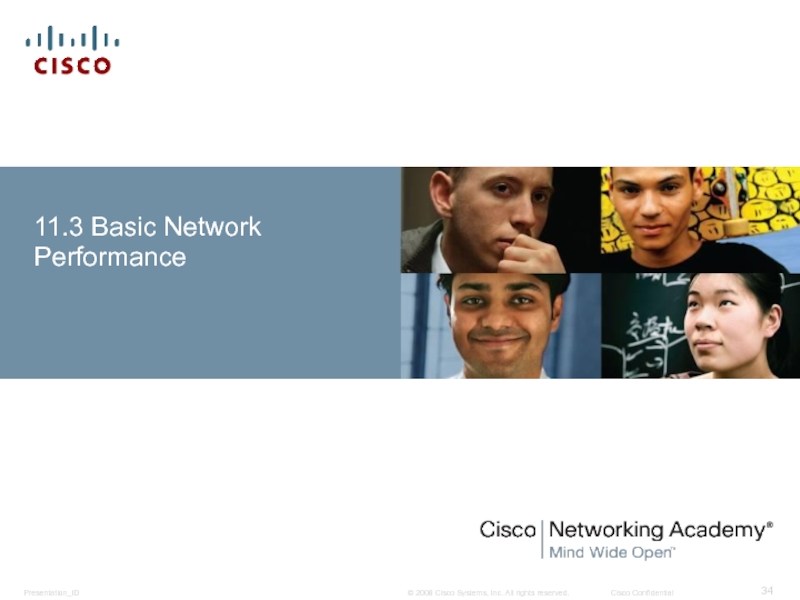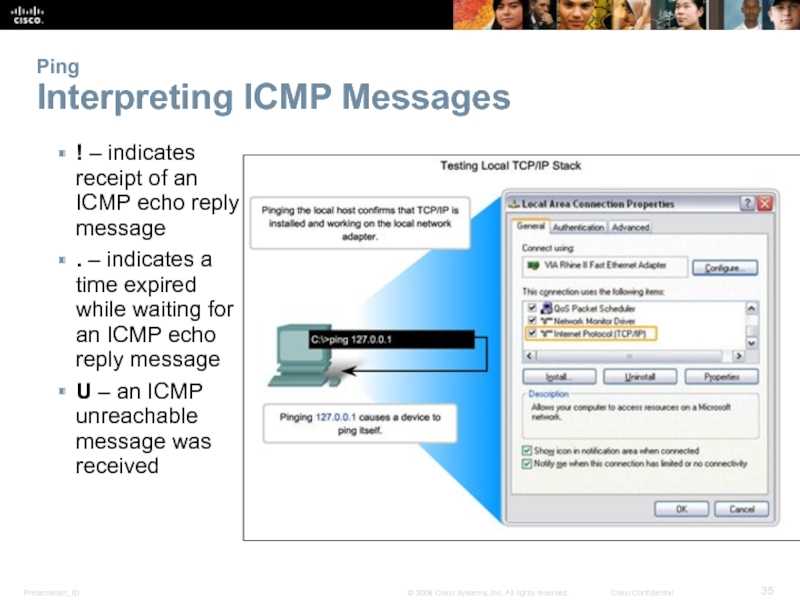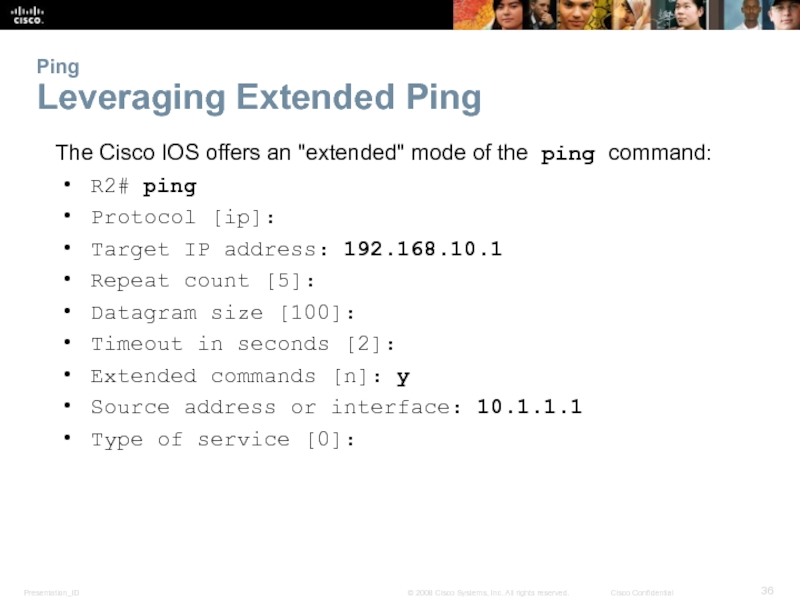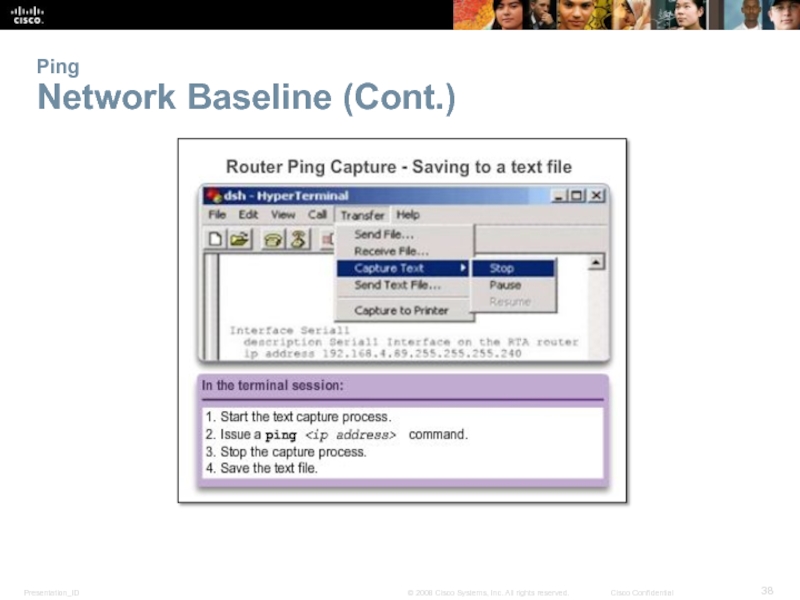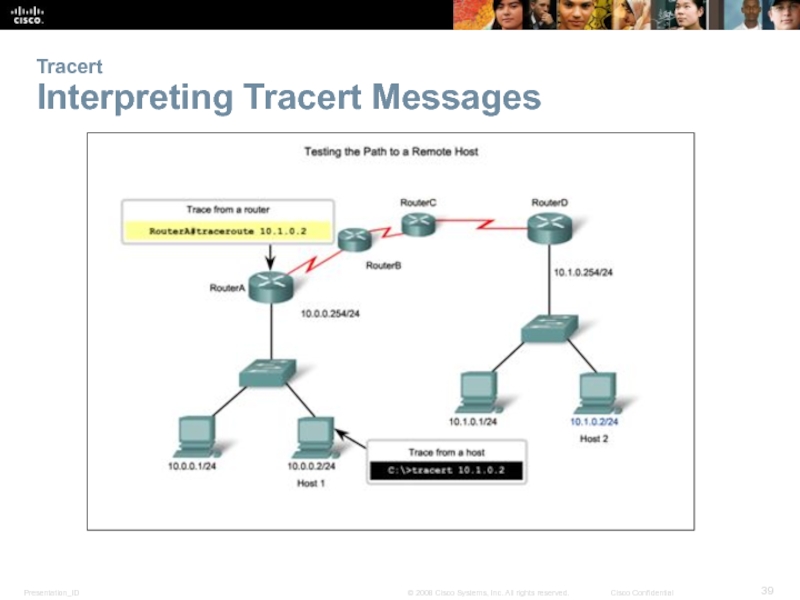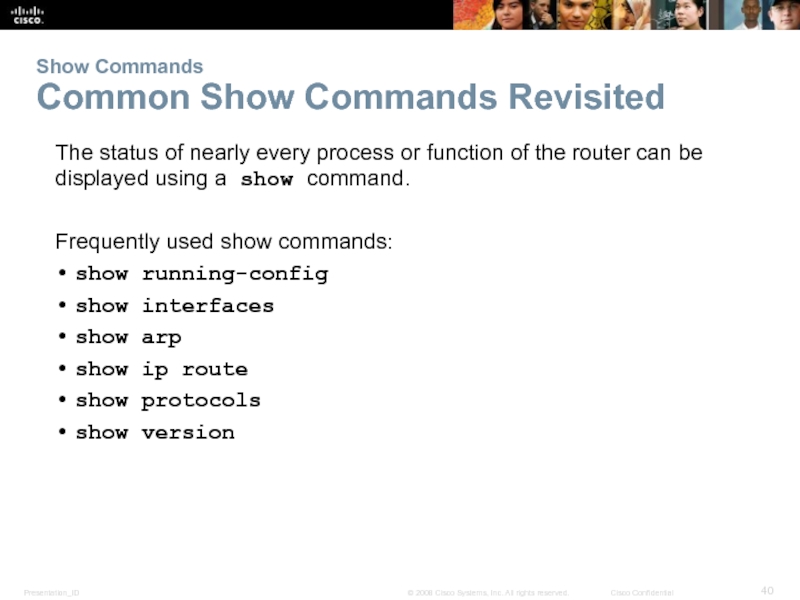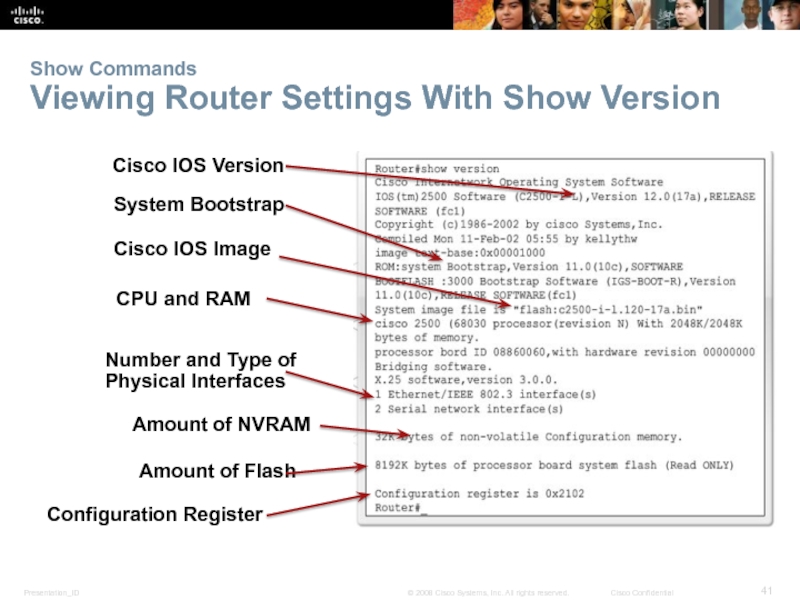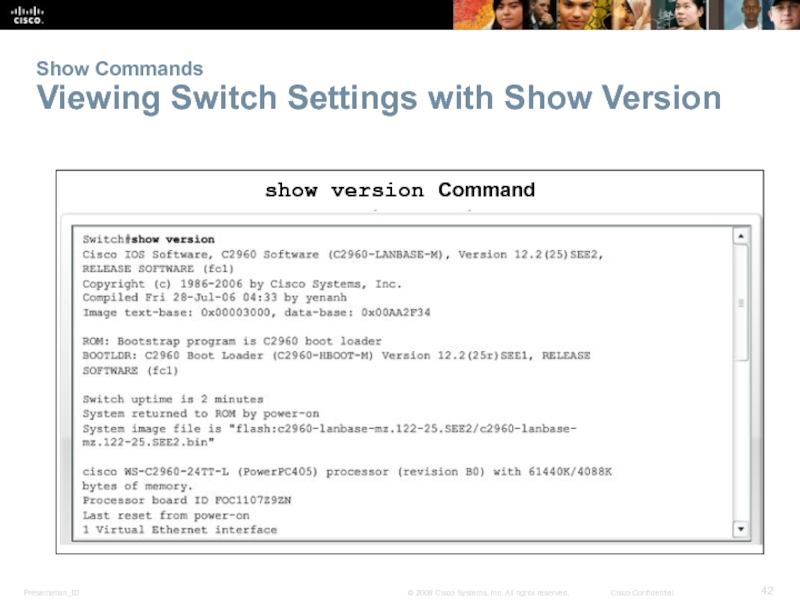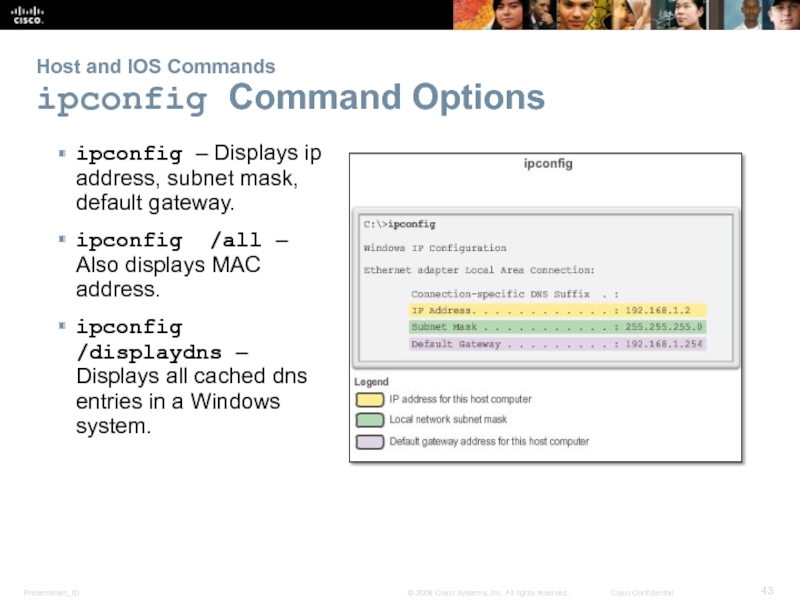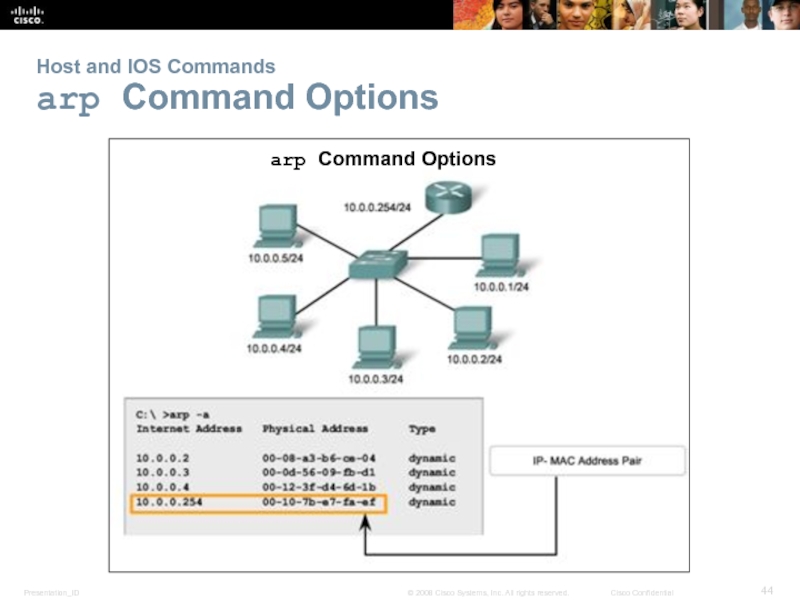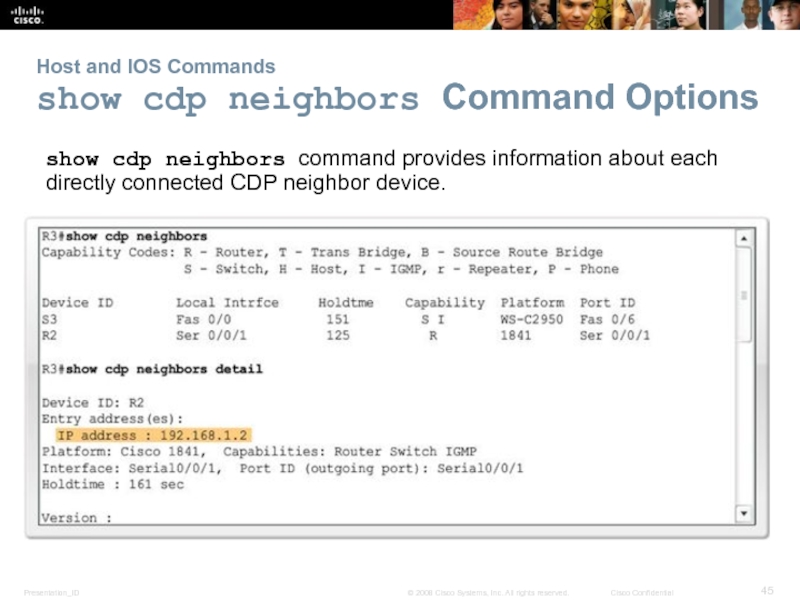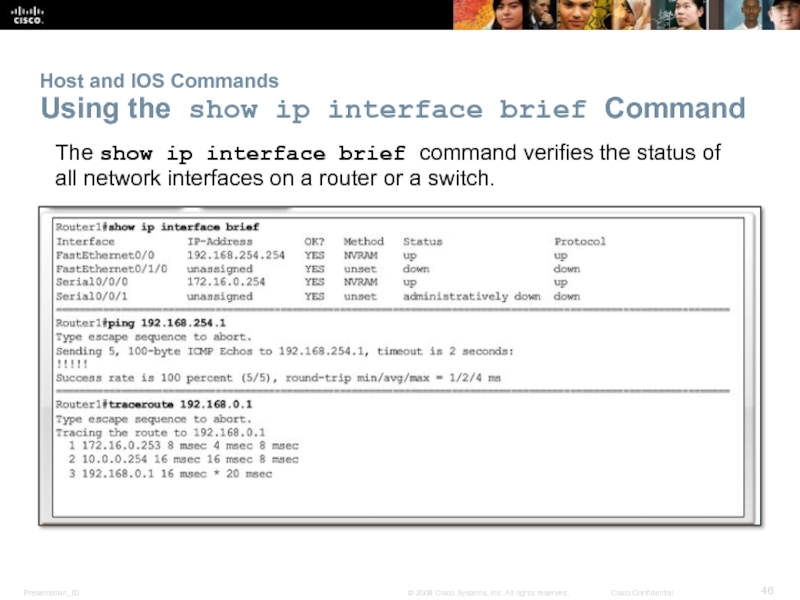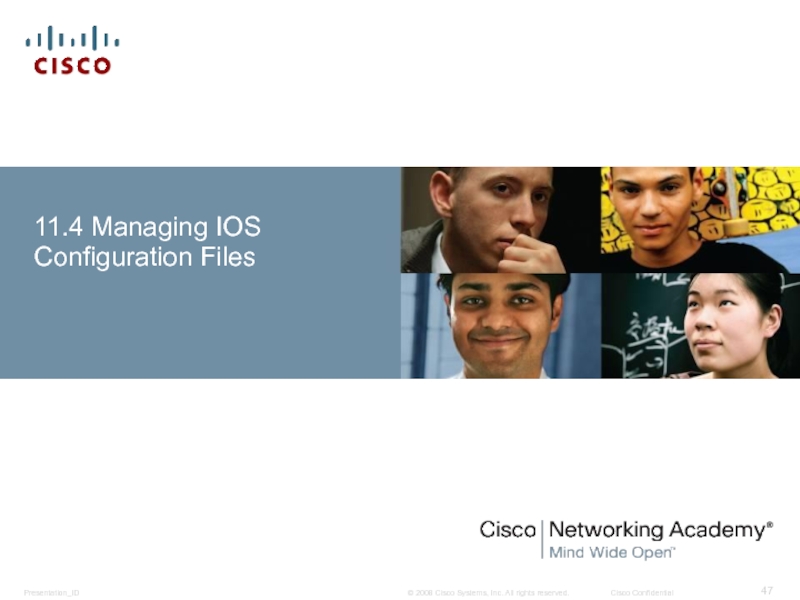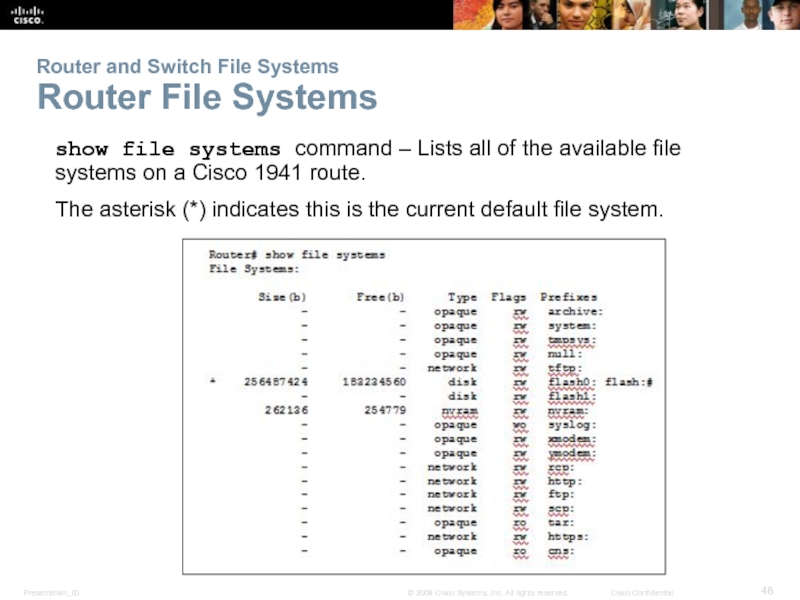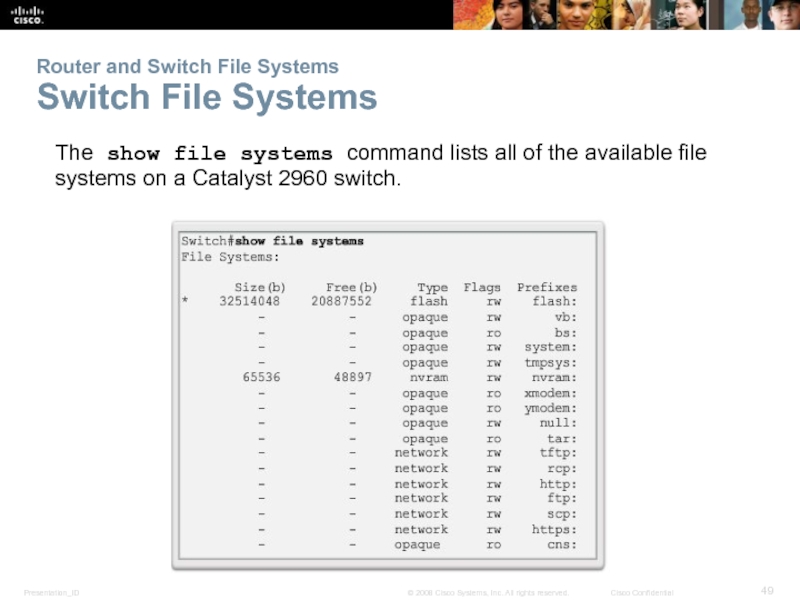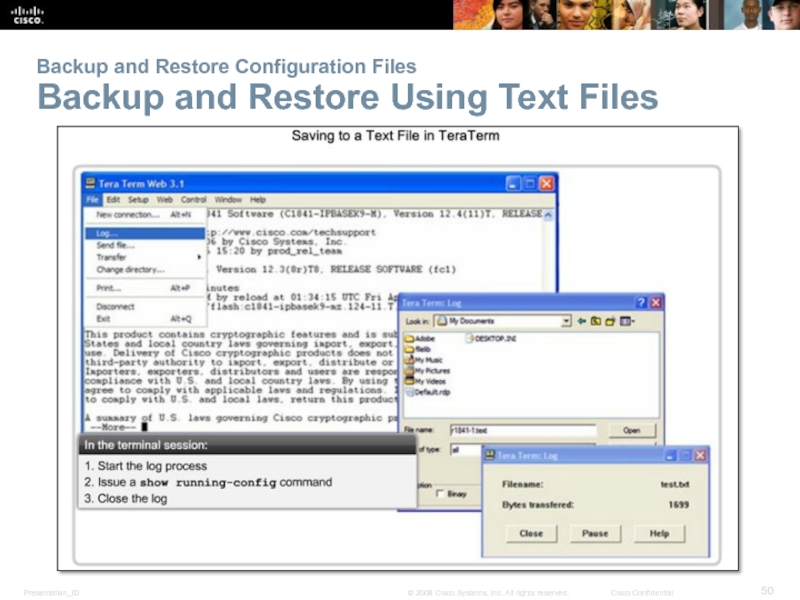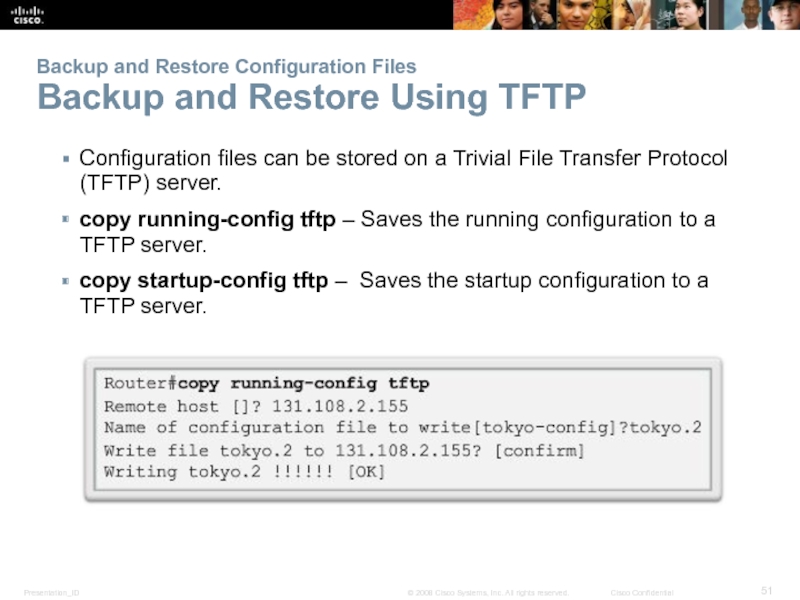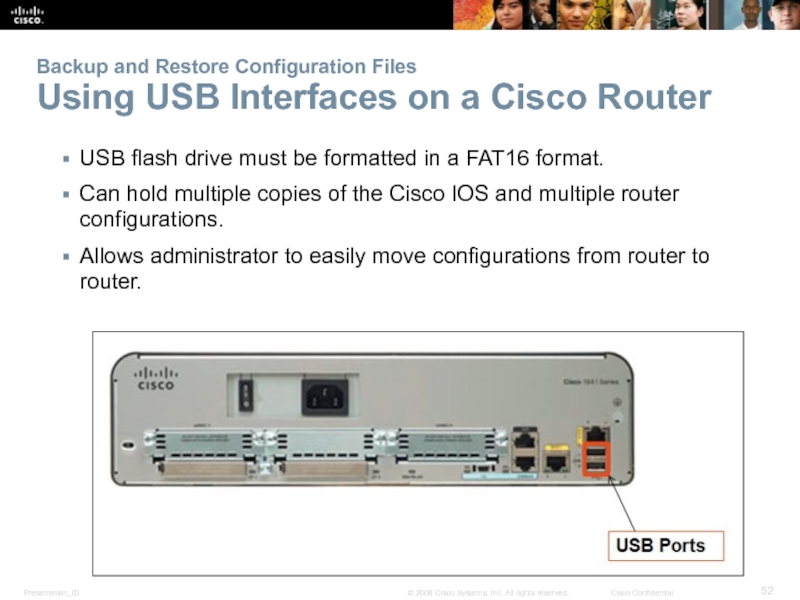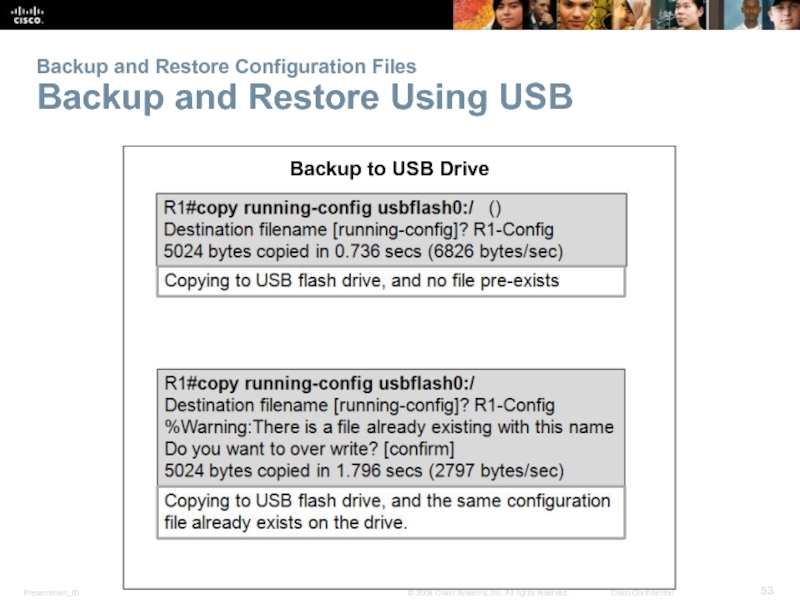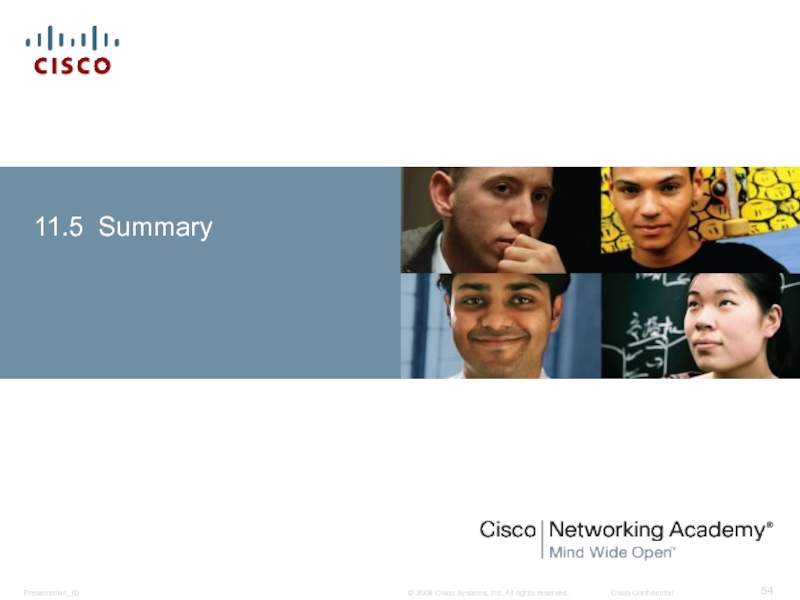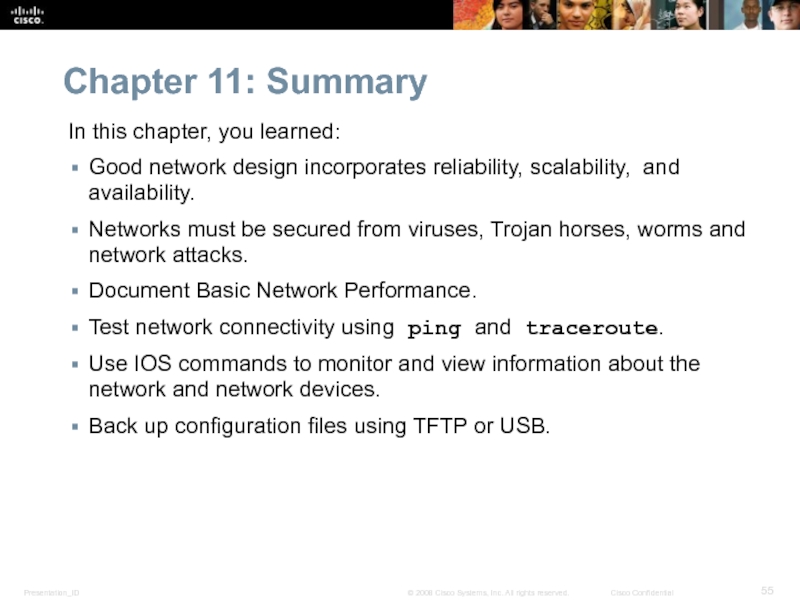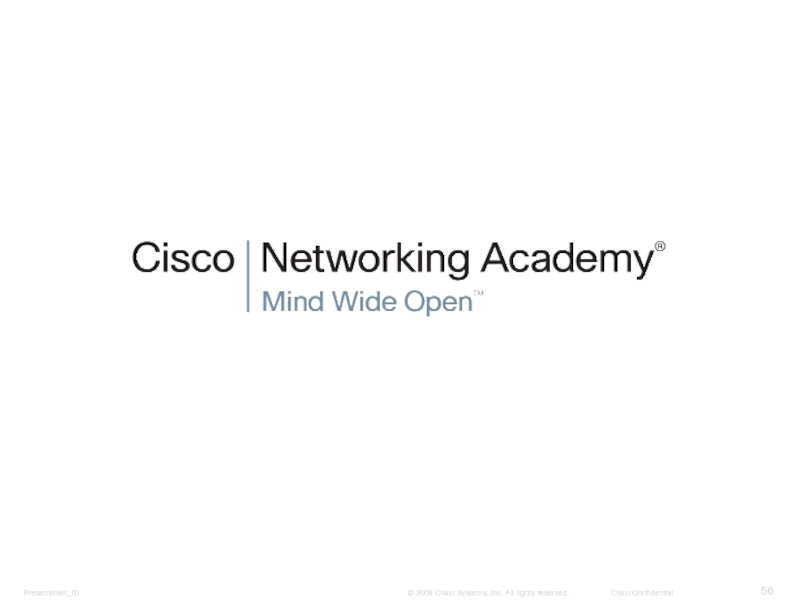- Главная
- Разное
- Дизайн
- Бизнес и предпринимательство
- Аналитика
- Образование
- Развлечения
- Красота и здоровье
- Финансы
- Государство
- Путешествия
- Спорт
- Недвижимость
- Армия
- Графика
- Культурология
- Еда и кулинария
- Лингвистика
- Английский язык
- Астрономия
- Алгебра
- Биология
- География
- Детские презентации
- Информатика
- История
- Литература
- Маркетинг
- Математика
- Медицина
- Менеджмент
- Музыка
- МХК
- Немецкий язык
- ОБЖ
- Обществознание
- Окружающий мир
- Педагогика
- Русский язык
- Технология
- Физика
- Философия
- Химия
- Шаблоны, картинки для презентаций
- Экология
- Экономика
- Юриспруденция
It’s a network. (Chapter 11) презентация
Содержание
- 1. It’s a network. (Chapter 11)
- 2. Chapter 11 11.0 Introduction 11.1 Create and
- 3. Chapter 11: Objectives Upon completion of this
- 4. Chapter 11: Objectives (Cont.) Use the basic
- 5. 11.1 Create and Grow
- 6. Devices in a Small Network Small Network Topologies Typical, Small Network Topology
- 7. Devices in a Small Network Device Selection
- 8. Devices in a Small Network Addressing
- 9. Devices in a Small Network Redundancy
- 10. Devices in a Small Network Design
- 11. Protocols in a Small Network Common
- 12. Protocols in a Small Network Common Protocols
- 13. Protocols in a Small Network Real-Time Applications
- 14. Growing to Larger Networks Scaling a Small
- 15. Growing to Larger Networks Protocol Analysis of
- 16. Growing to Larger Networks Evolving Protocol Requirements
- 17. 11.2 Keeping the Network Safe
- 18. Network Device Security Measures Categories of Threats
- 19. Network Device Security Measures Physical Security Four
- 20. Network Device Security Measures Types of Security
- 21. Vulnerabilities and Network Attacks Viruses, Worms, and
- 22. Vulnerabilities and Network Attacks Reconnaissance Attacks
- 23. Vulnerabilities and Network Attacks Access Attacks
- 24. Vulnerabilities and Network Attacks Access Attacks (Cont.)
- 25. Vulnerabilities and Network Attacks Denial of Service (DoS) Attacks
- 26. Mitigating Network Attacks Backup, Upgrade, Update,
- 27. Mitigating Network Attacks Authentication, Authorization, and
- 28. Mitigating Network Attacks Firewalls A Firewall
- 29. Mitigating Network Attacks Endpoint Security Common
- 30. Securing Devices Introduction to Securing Devices
- 31. Securing Devices Passwords Weak and Strong Passwords
- 32. Securing Devices Basic Security Practices Encrypt
- 33. Securing Devices Enabling SSH Enabling SSH
- 34. 11.3 Basic Network Performance
- 35. Ping Interpreting ICMP Messages ! – indicates
- 36. Ping Leveraging Extended Ping The Cisco IOS
- 37. Ping Network Baseline Baseline with ping
- 38. Ping Network Baseline (Cont.)
- 39. Tracert Interpreting Tracert Messages
- 40. Show Commands Common Show Commands Revisited The
- 41. Show Commands Viewing Router Settings With Show
- 42. Show Commands Viewing Switch Settings with Show Version show version Command
- 43. Host and IOS Commands ipconfig Command Options
- 44. Host and IOS Commands arp Command Options arp Command Options
- 45. Host and IOS Commands show cdp neighbors
- 46. Host and IOS Commands Using the show
- 47. 11.4 Managing IOS Configuration Files
- 48. Router and Switch File Systems Router File
- 49. Router and Switch File Systems Switch File
- 50. Backup and Restore Configuration Files Backup
- 51. Backup and Restore Configuration Files Backup
- 52. Backup and Restore Configuration Files Using
- 53. Backup and Restore Configuration Files Backup and Restore Using USB Backup to USB Drive
- 54. 11.5 Summary
- 55. Chapter 11: Summary In this chapter, you
Слайд 2Chapter 11
11.0 Introduction
11.1 Create and Grow
11.2 Keeping the Network Safe
11.3 Basic
11.4 Managing IOS Configuration Files
11.5 Summary
Слайд 3Chapter 11: Objectives
Upon completion of this chapter, you will be able
Identify the devices and protocols used in a small network.
Explain how a small network serves as the basis of larger networks.
Explain the need for basic security measures on network devices.
Identify security vulnerabilities and general mitigation techniques.
Use the output of ping and tracert commands to establish relative network performance.
Use basic show commands to verify the configuration and status of a device interface.
Слайд 4Chapter 11: Objectives (Cont.)
Use the basic host commands to acquire information
Explain the file systems on Routers and Switches.
Apply the commands to back up and restore an IOS configuration file.
Слайд 7Devices in a Small Network
Device Selection for a Small Network
Factors to
Слайд 8Devices in a Small Network
Addressing for a Small Network
IP addressing
Examples of devices that should be part of the IP design:
End devices for users
Servers and peripherals
Hosts that are accessible from the Internet
Intermediary devices
Planned IP schemes help the administrator:
Track devices and troubleshoot
Control access to resources
Слайд 9Devices in a Small Network
Redundancy in a Small Network
Redundancy helps
Improves the reliability of the network.
Слайд 10Devices in a Small Network
Design Considerations for a Small Network
The
Secure file and mail servers in a centralized location.
Protect the location by physical and logical security measures.
Create redundancy in the server farm.
Configure redundant paths to the servers.
Слайд 11Protocols in a Small Network
Common Applications in a Small Network
Network-Aware
Application Layer Services – Programs that interface with the network and prepare the data for transfer.
Слайд 12Protocols in a Small Network
Common Protocols in a Small Network
Network protocols
Processes on either end of a communication session
Types of messages
Syntax of the messages
Meaning of informational fields
How messages are sent and the expected response
Interaction with the next lower layer
Слайд 13Protocols in a Small Network
Real-Time Applications for a Small Network
Infrastructure –
VoIP – Is implemented in organizations that still use traditional telephones.
IP telephony – The IP phone performs voice-to-IP conversions.
Real-time video protocols – Use the Time Transport Protocol (RTP) and the Real-Time Transport Control Protocol (RTCP).
Слайд 14Growing to Larger Networks
Scaling a Small Network
Important considerations when growing to
Documentation – Physical and logical topology.
Device inventory – List of devices that use or comprise the network.
Budget – Itemized IT budget, including fiscal year equipment purchasing budget.
Traffic Analysis – Protocols, applications, services, and their respective traffic requirements should be documented.
Слайд 15Growing to Larger Networks
Protocol Analysis of a Small Network
Information gathered by
Слайд 16Growing to Larger Networks
Evolving Protocol Requirements
Network administrator can obtain IT “snapshots” of
Snapshots track network utilization and traffic flow requirements.
Snapshots help inform network modifications needed to optimize employee productivity.
Слайд 18Network Device Security Measures
Categories of Threats to Network Security
Categories of Threats
Слайд 19Network Device Security Measures
Physical Security
Four classes of physical threats are:
Hardware threats –
Environmental threats – Temperature extremes (too hot or too cold) or humidity extremes (too wet or too dry).
Electrical threats – Voltage spikes, insufficient supply voltage (brownouts), unconditioned power (noise), and total power loss.
Maintenance threats – Poor handling of key electrical components (electrostatic discharge), lack of critical spare parts, poor cabling, and poor labeling.
Слайд 20Network Device Security Measures
Types of Security Vulnerabilities
Types of Security Weaknesses:
Technological
Configuration
Security policy
Vulnerabilities
Слайд 21Vulnerabilities and Network Attacks
Viruses, Worms, and Trojan Horses
Virus – Malicious software
Trojan horse – An entire application written to look like something else, when in fact it is an attack tool.
Worms – Worms are self-contained programs that attack a system and try to exploit a specific vulnerability in the target. The worm copies its program from the attacking host to the newly exploited system to begin the cycle again.
Слайд 26Mitigating Network Attacks
Backup, Upgrade, Update, and Patch
Keep current with the
Install updated security patches.
Antivirus software can detect most viruses and many Trojan horse applications and prevent them from spreading in the network.
Слайд 27Mitigating Network Attacks
Authentication, Authorization, and Accounting
Authentication, Authorization, and Accounting (AAA,
Authentication – Users and administrators must prove their identity. Authentication can be established using username and password combinations, challenge and response questions, token cards, and other methods.
Authorization – Determines which resources the user can access and the operations that the user is allowed to perform.
Accounting – Records what the user accessed, the amount of time the resource is accessed, and any changes made.
Слайд 28Mitigating Network Attacks
Firewalls
A Firewall resides between two or more networks.
Packet Filtering
Application Filtering
URL Filtering
Stateful Packet Inspection (SPI) – Incoming packets must be legitimate responses to requests from internal hosts.
Firewalls
Слайд 29Mitigating Network Attacks
Endpoint Security
Common endpoints are laptops, desktops, servers, smart
Employees must follow the companies documented security policies to secure their devices.
Policies often include the use of anti-virus software and host intrusion prevention.
Common Endpoint Devices
Слайд 30Securing Devices
Introduction to Securing Devices
Part of network security is securing
Default usernames and passwords should be changed immediately.
Access to system resources should be restricted to only the individuals that are authorized to use those resources.
Any unnecessary services and applications should be turned off and uninstalled, when possible.
Update with security patches as they become available.
Слайд 32Securing Devices
Basic Security Practices
Encrypt passwords.
Require minimum length passwords.
Block brute force
Use Banner Message.
Set EXEC timeout.
Securing Devices
Слайд 35Ping
Interpreting ICMP Messages
! – indicates receipt of an ICMP echo reply
. – indicates a time expired while waiting for an ICMP echo reply message
U – an ICMP unreachable message was received
Слайд 36Ping
Leveraging Extended Ping
The Cisco IOS offers an "extended" mode of the
R2# ping
Protocol [ip]:
Target IP address: 192.168.10.1
Repeat count [5]:
Datagram size [100]:
Timeout in seconds [2]:
Extended commands [n]: y
Source address or interface: 10.1.1.1
Type of service [0]:
Слайд 40Show Commands
Common Show Commands Revisited
The status of nearly every process or
Frequently used show commands:
show running-config
show interfaces
show arp
show ip route
show protocols
show version
Слайд 41Show Commands
Viewing Router Settings With Show Version
Cisco IOS Version
System Bootstrap
Cisco
CPU and RAM
Configuration Register
Number and Type of Physical Interfaces
Amount of NVRAM
Amount of Flash
Слайд 43Host and IOS Commands
ipconfig Command Options
ipconfig – Displays ip address, subnet
ipconfig /all – Also displays MAC address.
ipconfig /displaydns – Displays all cached dns entries in a Windows system.
Слайд 45Host and IOS Commands
show cdp neighbors Command Options
show cdp neighbors command
Слайд 46Host and IOS Commands
Using the show ip interface brief Command
The show
Слайд 48Router and Switch File Systems
Router File Systems
show file systems command – Lists
The asterisk (*) indicates this is the current default file system.
Слайд 49Router and Switch File Systems
Switch File Systems
The show file systems command lists
Слайд 51Backup and Restore Configuration Files
Backup and Restore Using TFTP
Configuration files
copy running-config tftp – Saves the running configuration to a TFTP server.
copy startup-config tftp – Saves the startup configuration to a TFTP server.
Слайд 52Backup and Restore Configuration Files Using USB Interfaces on a Cisco
USB flash drive must be formatted in a FAT16 format.
Can hold multiple copies of the Cisco IOS and multiple router configurations.
Allows administrator to easily move configurations from router to router.
Слайд 55Chapter 11: Summary
In this chapter, you learned:
Good network design incorporates reliability,
Networks must be secured from viruses, Trojan horses, worms and network attacks.
Document Basic Network Performance.
Test network connectivity using ping and traceroute.
Use IOS commands to monitor and view information about the network and network devices.
Back up configuration files using TFTP or USB.
